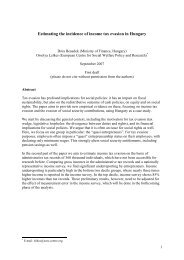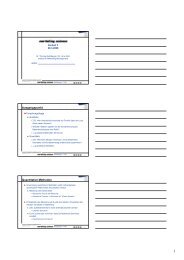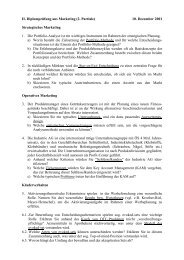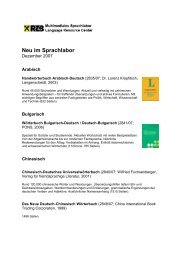Fund liquidation, self-selection and look-ahead bias in the hedge ...
Fund liquidation, self-selection and look-ahead bias in the hedge ...
Fund liquidation, self-selection and look-ahead bias in the hedge ...
Create successful ePaper yourself
Turn your PDF publications into a flip-book with our unique Google optimized e-Paper software.
conditional distribution of returns r i,t+1,...,r i,t+s+1<br />
given Ω t<br />
, which we<br />
<strong>the</strong><br />
by denote<br />
f (r i,t+1, ..., r i,t+s+1|Ω t<br />
), (3)<br />
f is generic notation for a (conditional) density function. Empirically,<br />
where<br />
can only obta<strong>in</strong> full <strong>in</strong>formation about this jo<strong>in</strong>t distribution if <strong>the</strong> fund<br />
we<br />
us denote this by Y it<br />
f(r i,t+1,...,r i,t+s+1|Ω t<br />
,Y it<br />
=1). (4)<br />
(3) <strong>and</strong> (4) are identical, <strong>liquidation</strong> <strong>and</strong> <strong>self</strong>-<strong>selection</strong> is exogenous <strong>and</strong><br />
If<br />
<strong>bias</strong>es arise if <strong>the</strong> sample <strong>selection</strong> process is ignored. However, as we<br />
no<br />
seen <strong>in</strong> <strong>the</strong> previous sections, it is likely that both <strong>liquidation</strong> <strong>and</strong> <strong>self</strong><strong>selection</strong><br />
have<br />
are determ<strong>in</strong>ed by historical performance <strong>and</strong> o<strong>the</strong>r characteristics<br />
may have a relation with returns dur<strong>in</strong>g <strong>the</strong> period t +1 to t+s+1. For<br />
that<br />
funds that have high levels of (idiosyncratic) risk are more likely<br />
example,<br />
have extreme returns <strong>and</strong> are typically less likely to survive (see Brown et<br />
to<br />
1992, or Hendricks, Patel <strong>and</strong> Zeckhauser, 1997). The difference between<br />
al.,<br />
Theroleofz it<br />
has not liquidated or <strong>self</strong>-selected dur<strong>in</strong>g <strong>the</strong> period t +1to t + s +1. Let<br />
=1. This means we can empirically identify<br />
<strong>and</strong> (4) drives <strong>the</strong> <strong>look</strong>-<strong>ahead</strong> <strong>bias</strong> <strong>in</strong> performance measures.<br />
(3)<br />
distribution of <strong>in</strong>terest <strong>in</strong> (3) can be derived from <strong>the</strong> jo<strong>in</strong>t distribu-<br />
The<br />
of r i,t+1, ..., r i,t+s+1<br />
<strong>and</strong> z it<br />
, conditional upon Ω t<br />
<strong>and</strong> Y it<br />
=1,wherez it<br />
tion<br />
a vector of observable fund characteristics <strong>and</strong> o<strong>the</strong>r variables that<br />
denotes<br />
are relevant for fund <strong>liquidation</strong> <strong>and</strong> <strong>self</strong>-<strong>selection</strong> from t +1to t + s +1.<br />
will become clear below. First, note that<br />
i,t+1,...,.r<br />
i,t+s+1,z<br />
it<br />
|Ω t<br />
,Y it<br />
=1)= f(r i,t+1,...,r i,t+s+1,z it<br />
,Y it<br />
=1|Ω t<br />
)<br />
f(r<br />
{Y it<br />
=1|Ω t<br />
}<br />
P<br />
P {Y it<br />
=1|r i,t+1, ..., r i,t+s+1,z it<br />
, Ω t<br />
}f (r i,t+1, ..., r i,t+s+1,z it<br />
|Ω t<br />
)<br />
=<br />
{Y it =1|Ω t }<br />
P<br />
(5)<br />
f i,t+1, ..., r i,t+s+1,z it<br />
|Ω t<br />
)<br />
= ,<br />
(r<br />
it w<br />
where<br />
P {Y it =1|Ω t }<br />
(6)<br />
w it<br />
=<br />
P {Y it =1|r i,t+1, ..., r i,t+s+1, Ω t ,z it }<br />
14







